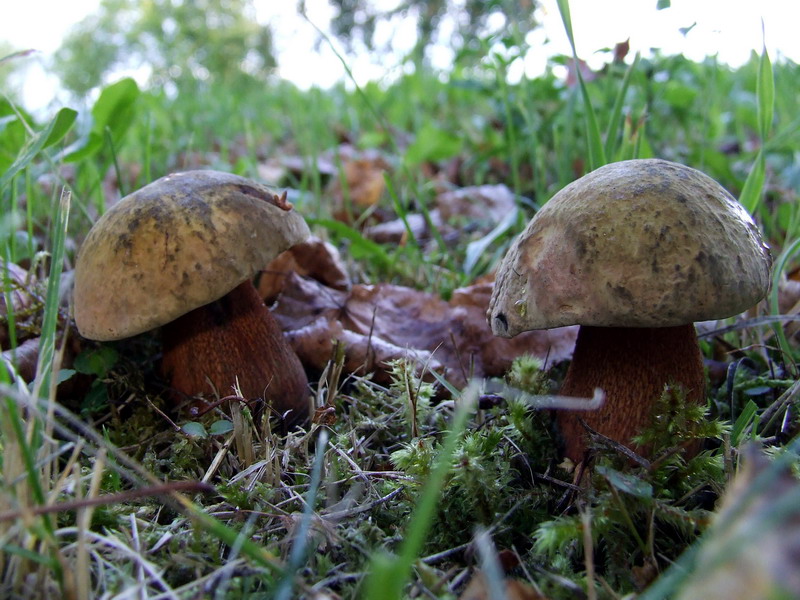- Boletus luridus
Taxobox
name = "Boletus luridus"

image_width = 280px
image_caption = "B. luridus",
regnum =Fungi
divisio =Basidiomycota
classis =Agaricomycetes
ordo =Boletales
familia =Boletaceae
genus = "Boletus "
species = "B. luridus"
binomial = "Boletus luridus"
binomial_authority = Schaeff. mycomorphbox
name = Boletus luridus
whichGills = adnate
capShape = convex
hymeniumType=pores
stipeCharacter=bare
ecologicalType=mycorrhizal
sporePrintColor=olive
howEdible=choice
howEdible2=caution"Boletus luridus", known as the lurid bolete, is a
fungus of the bolete family, found in deciduous woodlands in Europe and eastern North America. Fruiting bodies arise in summer and autumn and may be common. It is a solid bolete with an olive-brown cap, orange pores and stout ochre stem patterned with a reddish meshwork. Like several other red-pored boletes, it stains blue when bruised or cut. Though edible when cooked, it can cause gastric upset when raw and be confused with the poisonous "Boletus satanas ", though this has a pale cap.Taxonomy
"Boletus luridus" was described by Jacob Christian Schaeffer in 1774 and still bears its original name. [In Schaeffer's series on fungi of Bavaria and the Palatinate, " Fungorum qui in Bavaria et Palatinatu circa Ratisbonam nascuntur icones." published from 1762 onwards.] Its specific epithet is the
Latin adjective "luridus", 'sallow'.cite book | author = Nilson S. & Persson O. | year = 1977 | title = Fungi of Northern Europe 1: Larger Fungi (Excluding Gill-Fungi) | publisher = Penguin|isbn=0-14-063005-8|pages=p. 104] The American common name is lurid bolete. Both it and "Boletus satanas " are known as "ayimantari" 'bear mushroom' in Eastern Turkey.cite journal |author=Demirel K, Uzun Y, Kaya A |year=2004|title=Some Poisonous Fungi of East Anatolia |journal=Turk J Bot |volume=28|pages=215–19|id= |url=http://journals.tubitak.gov.tr/botany/issues/bot-04-28-1-2/bot-28-1-2-23-0207-2.pdf|format=PDF |accessdate= 2008-02-08]Description
"B.luridus" is a stout fungus with a yellow-olive to olive-brown convex cushion-shaped cap that can reach convert|20|cm|in|0|abbr=on in diameter. The cap surface is
tomentose (velvety), becoming smoother with old age, and sticky in wet weather. It has free orange or yellowish pores and yellow tubes underneath. The thick stem is colored with a red meshlike pattern on a paler ochre background. The flesh is yellowish, with red marks in the cap, and stains dark blue when bruised or broken. There is a faint sour smell and the taste is described as mild. The spore dust is olive coloured.cite book|author=Zeitlmayr L|year=1976|title=Wild Mushrooms:An Illustrated Handbook|publisher=Garden City Press, Hertfordshire|isbn= 0-584-10324-7|pages=p. 102] cite book | author = Haas H | year = 1969 | title = The Young Specialist looks at Fungi |pages=p. 126| publisher = Burke | id = ISBN 0-222-79409-7] Themycelium is an unusual yellow colour.cite book | author = Ramsbottom J | year = 1953 | title = Mushrooms & Toadstools |pages=p. 129 | publisher = Collins | id = ISBN 1870630092]"B. satanas" is larger, has a pale cap and a putrid smell at times.
Distribution and habitat
The fungus grows in association with
deciduous trees such as oak, birch and beech oncalcareous (chalky) soils, from June to November after summer rains. It may occur in parks near a single tree, though it will not be found in acidic soils. It is widespread in Europe, east to the Black Sea region and easternAnatolia inTurkey , [cite journal |author=Sesli E |year=2007|title=Preliminary checklist of macromycetesof the East and Middle Black Sea Regions of Turkey |journal=Mycotaxon |volume=99|pages=71–74|url=http://www.mycotaxon.com/resources/checklists/sesli-v99-checklist.pdf|format=PDF|accessdate=2008-01-28] as well as in the Eastern United States and Canada.cite book |title=Poisonous Mushrooms of the Northern United States and Canada |author=Ammirati JA, Traquair JA, Horgen PA |year=1985|publisher=University of Minnesota Press |location=Minneapolis |isbn=0-8166-1407-5|pages=p. 240-41] It has been recorded fromLa Malinche National Park inMexico ,cite journal |author=Montoya A, Kong A, Estrada-Torres A, Cifuentes J, Caballero J|year=2004|title=Useful wild fungi of La Malinche National Park, Mexico |journal=Fungal diversity |volume=17|pages=115–43|url=http://www.fungaldiversity.org/fdp/sfdp/17-8.pdf|format=PDF |accessdate=2008-02-04] and once fromCosta Rica . [cite web| author = Halling RE, Mueller GM| title = Boletus luridus| work = New York Botanic Garden:Macrofungi of Costa Rica| publisher = New York Botanic Garden| date = 2008| url = http://www.nybg.org/bsci/res/hall/bollurid.html|accessdate =2008-02-04]Toxicity
Mild tasting, "Boletus luridus" is edible after thorough cooking and has been reported as popular in France. However, caution is advised as it resembles other less edible blue-staining boletes and should be avoided by novice mushroom hunters. It can cause nausea and vomiting if eaten raw or insufficiently cooked, or with alcohol. It is not considered edible in Mexico.
References
Wikimedia Foundation. 2010.
